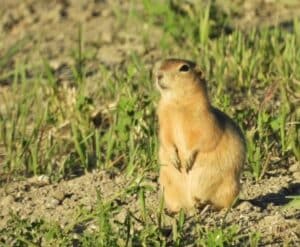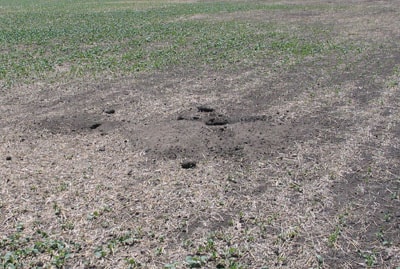The best time to manage Richardson’s ground squirrels (Urocitellus richardsonii), commonly known as gophers, is late winter and early spring as they emerge from their burrows and before primary food sources start to green up.
Best management practices
1. Assess the risk
An Alberta government factsheet says a good technique to estimate ground squirrel numbers is to count the active mounds within 1m (basically in front of you) while walking 100m. One active mound per two strides is considered a heavy population. A nominal action threshold for a colony is one active mound per four strides or 20 per cent crop damage over 100m.
2. Rodenticide
Rodenticide poisoning can be effective, but timing is critical. March 15 to April 30 is the best time to manage Richardson’s ground squirrels. This timing targets the breeding adults so fewer babies will be born. Waiting until June when gophers have started to eat the crop is too late.
Strychnine is now banned in Canada for burrowing rodent control, in part because of significant toxicity and risk to off-target animals.
Saskatchewan and Alberta research shows that zinc phosphide baits, ZP Rodent Oat Bait AG and Burrow Oat Bait can be as effective as strychnine if deployed before the rest of the landscape greens up. Once green-up occurs, ground squirrels tend to prefer fresh green plant material.
The same early spring timing also works best for anticoagulant rodenticides like Rozol and Ramik Green. Anticoagulants can take seven to 10 days to kill and during this time, the toxin can accumulate in multiple tissues but concentrates in the liver. Weakened rodents can present an excellent opportunity to predators and a greater possibility of secondary poisoning. However, if cadavers are removed, as per label instructions, anticoagulant baits can also be effective, and some growers report good results.
Bait stations are permitted for zinc phosphide and these anticoagulants but must be secure and inaccessible to livestock, pets and children. Insert bait into multiple holes as a quick and easy way to deploy it.
3. Raptor platforms
Hawks, owls and other predatory birds can catch and eat a lot of gophers. Raptor platforms and nest boxes in areas with perennial gopher problems give the birds a perch from which to hunt. A Saskatchewan report says “work done in California showed that raptors were 67 per cent more effective than rodenticides.” However, that work was done on another ground squirrel species.
The Alberta factsheet says one platform per quarter section is adequate in areas of limited trees, and notes that platforms need to be at least 10 feet (3m) high. Two round bales standing on end can be enough to attract raptors to nest, it adds.
More on raptors and platforms.
4. Taller grass and crops
Gophers prefer short grass because they can see predators. Slow stand establishment contributed to the problem in 2024, says Jim Tansey, insect and vertebrate pest management specialist for the Saskatchewan Ministry of Agriculture. “They don’t like tall vegetation, so are normally an issue on field edges,” Tansey says. “In 2024, they established much further into fields than I have seen in recent years and were causing major issues on large areas well into the crop, with a very apparent preference for seedling canola.”
5. Alternative control methods
- Fumigants. Fumigants release toxic gas within the burrow system. These products cannot be purchased without an applicator license for fumigation.
- Trapping. This can be an effective method to control adults as they emerge from winter hibernation.
- Shooting. Again, this can work well with small infestations and where local laws allow it.
For more on these and other alternative methods, read the Alberta Agriculture factsheet.
More…
- Alberta factsheet on Richardson’s ground squirrels (Note: the content on strychnine is old. Other tips are good.)
- Saskatchewan factsheet on Richardson’s ground squirrels


